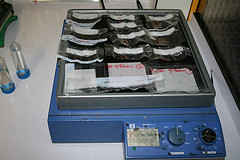Phage display – the process of genetically fusing antibody fragments with phage to identify binding partners to your protein of interest – was covered pretty thoroughly here over the past few months. The success of this assay predicates on creating a diverse library of up to 1012 genes coding for these antibody fragments. Despite being so important to the success of phage display, this step also represents the most difficult experimental challenge. To address this, phage display libraries are easy to obtain commercially, adding to the widespread acceptance of the technique. This results in either a proprietary “black box” of the commercial sector or an increased sense of “who cares? It works, right?” by researchers.
In an effort to make that black box a bit more opaque, we’ll discuss these libraries, some options that are available to purchase or make these libraries in house, and what the implications are of these differences.
Phage Display Libraries: An Origin Story
The whole idea of phage display is to identify a molecule that binds to things (usually proteins, but not always). It makes sense then that these libraries are commonly derived from a type of protein that we know is really good at binding things: the antibody. The cells that generate these antibodies, B-cells, are isolated from the blood prior to exposure to antigen. This ensures that the cell is capable of coding a huge repertoire of potential antibody binding regions. It is from the transcripts of these genes that cDNA is generated, and PCR products of these cDNAs are ultimately cloned into the phage vector (more on this later). If you are using phage display to detect an antigen visible to the human immune system, this system is likely a poor choice; the immune system has already removed any B-cells that produce good binding antibodies.
The How Behind Building Phage Display Libraries
There are also a few variations on how these libraries are generated. One option is to create an immunized library, in which an animal model is injected with the protein of interest to “prime” the immune system prior to isolating the B-cells. This improves the chances of finding a very good binding antibody, but does so at the expense of library diversity. However, it prevents selection against a protein that is natively expressed on the cell surface. Another approach is a synthetic library, in which degenerate primers are used in a PCR reaction to amplify the variable regions of B cells. These primers are a mixture of randomized oligonucleotides, which contain sufficient base-pairing for ligation, but are randomized in single or multiple sites throughout. These primers create large libraries quickly that contain none of the bias introduced by the immune system.
How the Antibody Comes Together
A semi-synthetic system is created when the non-variable framework of the antibody is taken into account as well.
Just for some pertinent background information, a normal antibody molecule consists of a heavy chain and a light chain. The light chain is bound via disulfide bonds to the VH and CH1 (Heavy chain, variable region and Heavy chain, constant region 1) of the heavy chain. The light chain regions responsible for the binding are referred to as a VL and CL domains (Light chain, variable region and light chain, constant region). The variable regions are responsible for antigen binding, and the non-variable amino acids form framework regions responsible for the structural integrity of the molecule.
In a semi-synthetic library, these framework regions are amplified and cloned into the phage display library from B-cells, in differing combinations to achieve different goals. In a synthetic library, these framework regions are pre-identified and cloned out of an already-existing system for use.
A Library Type for All Needs
As mentioned, these regions are used in varying combinations to create different types of libraries. For a Fab library, the variable and constant regions of both the heavy and the light chain are fused to gene III of the phage on a phagemid. This is the largest phage display option, and sacrifices solubility for library size. An scFv library combines only the variable regions of the light and heavy chain, and a sdAb library uses only the heavy chain variable fragment. In general, as the fragments become smaller, they also become more soluble and easier to express and ultimately purify in a recombinant form.
Once the regions of interest are identified and amplified, they are inserted into a plasmid. These plasmids, if not available via collaboration, are available commercially though multiple companies, including NEB and Merck Millipore. The NEB kit is a part of the Ph.D. system, which uses the M13 phage, and the Merck Millipore kit uses the T7 phage. Functionally, there is very little difference between these two systems save for a few finite details, which are not significant enough to delve into here.
Of course, libraries of all different types and sizes are commercially available, if you have a “I need a monoclonal antibody against protein X” situation facing you on the bench. However, you can create your own library or use pre-immunized B-cells to help direct the selection to purify the best antibody possible. Hopefully this overview is helpful in starting you down that road.







